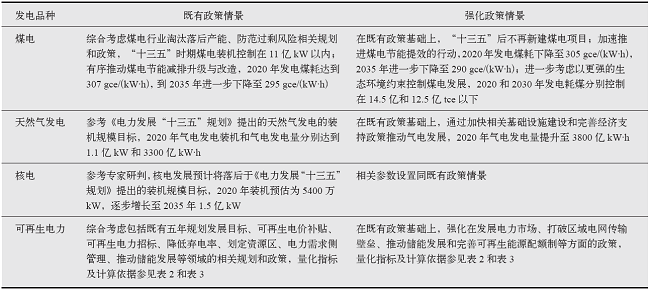| [1] |
International Energy Agency. World energy outlook 2015 [EB/OL]. 2015 [2017-08-01]. http://www.iea.org/Textbase/npsum/WEO2015SUM.pdf
|
| [2] |
IPCC. Fifth assessment report climate change: mitigation of the climate change [R]. London: Cambridge University Press, 2014
|
| [3] |
解振华. 中国低碳发展宏观战略研究总报告[M]. 北京: 人民出版社, 2017.
|
|
Xie Z H. Report on China’s macro strategy on low carbon development [M]. Beijing: China People’s Publishing House, 2017 (in Chinese)
|
| [4] |
World Bank. World bank index [EB/OL]. 2019 [2019-07-30]. http://data.worldbank.org/data-catalog/world-development-indicators/
|
| [5] |
刘强, 田川, 郑晓奇, 等. 中国电力行业碳减排相关政策评价[J]. 资源科学, 2017,39(12):2368-2376.
doi: 10.18402/resci.2017.12.15
URL
|
|
Liu Q, Tian C, Zheng X Q, et al. Evaluation of CO2 emission reduction policies in China’s power sector[J]. Resources Science, 2017,39(12):2368-2376 (in Chinese)
|
| [6] |
王玥玥. 基于系统动力学的电力行业碳排放预测研究[D]. 北京: 华北电力大学, 2017.
|
|
Wang Y Y. Carbon emission of power industry prediction research based on system dynamics[D]. Beijing: North China Electric Power University, 2017 (in Chinese)
|
| [7] |
王喜平, 王玥玥. 基于系统动力学的电力行业碳排放预测[J]. 陕西电力, 2016,44(6):9-32.
|
|
Wang X P, Wang Y Y. Power industry carbon emissions prediction based on system dynamics[J]. Shanxi Electric Power, 2016,44(6):9-32 (in Chinese)
|
| [8] |
白泉, 康晓文, 陶冶. 重塑能源: 中国面向2050年能源消费和生产革命路线图(电力卷)[M]. 北京: 中国科学技术出版社, 2017.
|
|
Bai Q, Kang X W, Tao Y. Reinventing fire: a roadmap for China’s revolution in energy consumption and production to 2050 (Electricity Volume) [M]. Beijng: China Science and Technology Press, 2017 (in Chinese)
|
| [9] |
2050中国能源和碳排放研究课题组. 2050中国能源和碳排放报告[M]. 北京: 科学出版社, 2009.
|
|
2050 China’s Energy and CO2 Emissions Research Group. 2050 China energy and CO2 emissions report [M]. Beijing: Science Press, 2009 (in Chinese)
|
| [10] |
马丁, 陈文颖. 中国2030年碳排放峰值水平及达峰路径研究[J]. 中国人口·资源与环境, 2016,26(5):1-4.
|
|
Ma D, Chen W Y. Analysis of China’s 2030 carbon emission peak level and peak path[J]. China’s Population, Resources and Environment, 2016,26(5):1-4 (in Chinese)
|
| [11] |
朱然. 基于TIMES模型的电力行业控制CO2方案优选[D]. 北京: 北京交通大学, 2011.
|
|
Zhu R. Technical optimization for CO2 control in power industry: an analysis with the world-times model[D]. Beijing: Beijing Jiaotong University, 2011 (in Chinese)
|
| [12] |
国网能源研究院有限公司. 中国能源电力发展展望2017 [M]. 北京: 中国电力出版社, 2017.
|
|
State Grid Energy Research Institute Co., LTD. China energy and electricity outlook [M]. Beijing: China Electric Power Press, 2017 (in Chinese)
|
| [13] |
能源研究所和国家可再生能源中心. 中国可再生能源展望2018 [EB/OL]. 2018 [2019-08-01]. http://boostre.cnrec.org.cn/wp-content/uploads/2018/11/CREO-2018-Summary-CN.pdf.
|
|
Energy Research Institute of Academy of Macroeconomic Research/NDRC, China National Renewable Energy Centre. China renewable energy outlook 2018 [EB/OL]. 2018 [2019-08-01]. http://boostre.cnrec.org.cn/wp-content/uploads/2018/11/CREO-2018-Summary-CN.pdf(in Chinese)
|
| [14] |
Zhang Y Z, Zhao X G, Zuo Y, et al. The development of the renewable energy power industry under feed-in tariff and renewable portfolio standard: a case study of China’s photovoltaic power industry[J]. Sustainability, 2017,9:532
doi: 10.3390/su9040532
URL
|
| [15] |
International Energy Agency. Energy technology perspectives 2017 [EB/OL]. 2017 [2018-03-01]. http://www.oecd.org/about/publishing/Corrigendum_EnergyTechnologyPerspectives2017.pdf
|
| [16] |
Danish Energy Agency. Energy strategy 2050 [EB/OL]. 2018 [2018-08-01]. https://oim.dk/media/19094/energiudspil2604.pdf
|
| [17] |
戴彦德, 田智宇, 杨宏伟, 等. 中国:面向2050年能源消费和生产革命路线图综合卷[M]. 北京: 中国科学技术出版社, 2017.
|
|
Dai Y D, Tian Z Y, Yang H W. China: a roadmap for China’s revolution in energy consumption and production to 2050 (Comprehensive Volume) [M]. Beijng: China Science and Technology Press, 2017 (in Chinese)
|
| [18] |
中国尽早实现二氧化碳排放峰值的实施路径研究课题组. 中国碳排放尽早达峰[M]. 北京: 中国经济出版社, 2017.
|
|
Implementation Pathway Research Group on Earliest Peaking the Carbon Emission of China. Earliest peaking the carbon emission of China [M]. Beijing: China Economic Publishing House, 2017 (in Chinese)
|
| [19] |
Yuan J H, Na C N, Lei Q, et al. Coal use for power generation in China[J]. Resources, Conservation and Recycling, 2018,129:443-453
|
| [20] |
陈宗法. 我国煤电困局破解之策的探讨[EB/OL]. 2019 [2019-08-07]. http://www.cpnn.com.cn/zdyw/201907/t20190731_1145948.html.
|
|
Chen Z F. Discussion on the solution of China’s coal power dilemma [EB/OL]. 2019 [2019-08-07]. http://www.cpnn.com.cn/zdyw/201907/t20190731_1145948.html(in Chinese)
|
| [21] |
傅莎, 邹骥. “十三五”煤电零增长也能满足中国未来电力需求[J]. 世界环境, 2016,4:77-79.
|
|
Fu S, Zou J. Zero growth in coal power capacity could meet China’s future electricity demand[J]. World Environment, 2016,4:77-79 (in Chinese)
|
| [22] |
袁家海, 张文华. 中国煤电过剩规模量化及去产能路径研究[J]. 中国能源, 2017,39(8):14-20.
|
|
Yuan J H, Zhang W H. Quantification on the overcapacity and the pathway of cutting the overcapacity of China’s coal power[J]. China Energy, 2017,39(8):14-20 (in Chinese)
|
| [23] |
袁家海, 雷祺, 王杨. 经济新常态下中国电力需求展望及煤电前景分析[J]. 中国能源, 2015,37(7):21-27.
|
|
Yuan J H, Lei Q, Wang Y. Outlook on China’s electricity demand and the development of coal power under economic new normal[J]. China Energy, 2015,37(7):21-27 (in Chinese)
|
| [24] |
Teng F, Liu Q, Gu A, , et al. Pathways to deep decarbonization in China [EB/OL]. 2015 [2019-08-07]. https://www.iddri.org/sites/default/files/old/Publications/CHN_DDPP_report.pdf
|
 ), TIAN Chuan1, CAO Ying1, LIU Qiang1, ZHENG Xiao-Qi2(
), TIAN Chuan1, CAO Ying1, LIU Qiang1, ZHENG Xiao-Qi2( )
)








